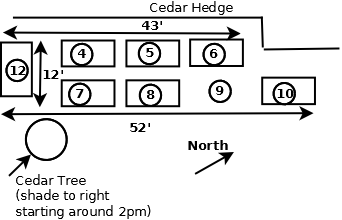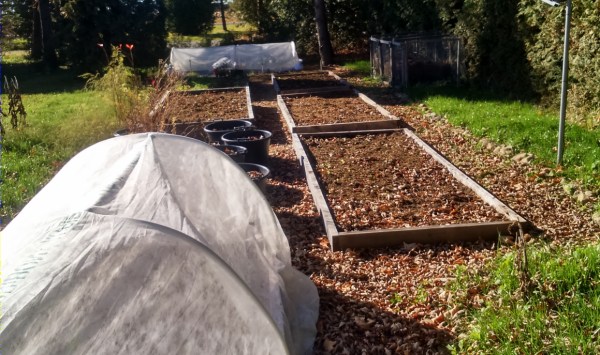 |
| mail us
navigation
|
All gardening is site specific. This page provides detail on the location, layout and conditions to allow readers to make their own assessment of applicability to their own unique circumstances.
Location: Rural location, about 5 kilometers west of St. Augustin, Mirabel, Quebec.
Co-ordinates: 45.6o North and 74o West. Elevation: 82m (250 feet).
USDA Zone: 4B.
Last Frost Date: 15th May.
First Frost Date: Very Variable. 2014: 9th September, 2015: 19th October
Prevailing wind: Mostly South West in summer (June to September) moves to to North East (November to May). Average speed 4 - 7 mph (7 - 12K/h). Max Speed 42 mph (69 K/h), Max gust: 67 mph (109 K/h)
Average Rainfall: April - May 75mm (3.1 inches), June - Sept 95mm (3.7 inches), Oct 85mm (3.3 inches). Mostly snow remainder of year.
Snowfall: Mean accumulation (March): 20 inches (52 cm), Max: 33 inches (85 cm). Max daily snow: 10 - 18 inches (25 - 46 cm)
Average Temperatures: April 5C (41F), May 12C (53F), June 17C (62F), July 20C (68F), August 18C (64F), September 13C (55F), October 7C (44F). Peaks to around 31 - 33C (87 - 91F). Remainder of year - very cold!
Surrounding Environment: Conventional Cereal Farming on 2 sides (classic Corn, Soya rotation) with about 100' (33m) separation from garden. 3rd side (front) has open aspect to road. Domestic residence on 4th side about 75' (50m) distant. Drainage ditches on 3 sides of property. Trees (mostly cedar hedging) on 3 sides except front which has an open aspect to the prevailing wind.
Native Soil: Very Heavy blue clay. Some parts of garden (about 25% by area, not including the vegetable plot) have imported topsoil about 6" deep following remediation efforts after replacement of septic tank in fall 2013.
Water: Well water from on-site well and pump.
Total Rear Garden Size: Approximately 80' (28m) x 400' (130m).
Vegetable Plot Layout and Orientation (2015):

Sun: Plot is approximately 52' (16m) x 12' (3.5m) and unless noted otherwise has between 6-7 hours sun per day during May/June/July/August/September.
The beds are numbered throughout the garden. While this may look super scientific it greatly simplifies note taking. Writing "bed 4" is a lot quicker than writing the "bed beside the tree at the back". The apparent randomness of the numbers simply reflects the order in which they were built or commissioned. Description:
Note: The depth figure reflects the depth of modified soil - below that is unmodified blue clay.
The beds are surrounded by 12 - 18" mulched pathways then break to a 'wilderness area' - essentially unrestrained weeds (occasionally cut with a 'trimmer') either under or immediately adjacent to trees (cedar, larch and deciduous mix) on three sides and to grass/clover lawn on 4th side. This will change in 2016 with the installation of a 4 - 6 foot band of (hopefully) beneficial plants on all sides. The objective is to reduce the maintenance load (no occasional trimming), remove the wilderness haven for bad bugs well as provide a habitat for good bugs. And besides, I like the idea of being surrounded by season-long flowers. Call me a chocolate-box gardener if you want.

Photo taken on a gloriously sunny day in November 2015 from beside bed 10 around 11pm. Wind blown leaves cover most of the paths and beds. Beds and pots were mostly cleared in mid October (after first frost) and seeded late October with winter cover of ryegrass (60%), cereal rye (10%) and peas (30%). Bed 7 still has the remains of the seasons carrots, Bed 12 (with frost cover) has onions and leeks seeded late July as an experiment (been yielding baby leeks and green onions since mid October) and bed 10 (with frost cover) which has lettuce, arugula, spinach, carrots and radishes seeded late september. The lush green visble on left and right hand sides of the photo is the first phase of the planned 2016 beneficial borders. The clay soil was turned over (about 6 - 9" deep) to compost weeds, lightly raked and seeded, in early thru late september as it was dug over, with ryegrass (70%), radish(10%) and turnip (20%) which should all winter kill. The border will be frost-seeded (maybe early December or around first snow) using approx 50% of my collected seed stock consisting of french marigolds, nasturmium, lupins, sunflower, poppy, multiple daisy varieties and Queen Anne's Lace using hand broadcast with no bed preparation. The remainder of the seed will be sown as early as possible after snow melt in spring (early April?), Again, I'm planning no more bed preparation, just hand broadcast onto the mat. Partly this is sloth, partly I have a lot of seed (even a 5 - 10% success would probably be enough), partly this is an experiment to see how effective this technique (actually Mother Nature) is in getting adequate seed/soil contact. I may take a smallish area (20% of total in two spots) and do some bed preparation in spring as a comparison. However, there are a lot of variables at work, in particular this is the first time I've collected seed and, while I was careful to wait long enough to harvest, I have no idea of its quality.
Note: The Government of Canada (as do most national governments) maintains a number of climate databases obtained from its weather stations. The data for this site report was extracted from the Canadian climate database for the weather station at Mirabel, QC, CA.
Problems, comments, suggestions, corrections (including broken links) or something to add? Please take the time from a busy life to 'mail us' (at top of screen), the webmaster (below) or eagle-eyes at hillofbeans. You will have a warm inner glow for the rest of the day.
|
Copyright © 2005 - 2026. HillofBeans.Org. All rights reserved. |
web-master at hillofbeans Page modified: January 20 2022 |